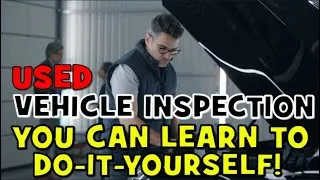DIY VEHICLE INSPECTION CHECKLIST

DIY VEHICLE INSPECTION
Tips for doing Your own Vehicle Inspection
Welcome to The Homework Guy website, where we empower Car Buyers with the knowledge to make smarter car-buying decisions!
This report written by Kevin Hunter The Homework Guy and the Amazing Elizabeth The Homework Gal. We know quite a few used car buyers are in our audience because we’ve been talking to many different members on our channel who are in the market for a used car. You are the ones who will seriously appreciate this!
Yes, and today, we’re diving head-first into one of the most important aspects of the world of buying used cars! And this is something you can get started on yourself, before you involve a mechanic! We’e talking about a pre-purchase vehicle inspection!
We’ve always believed in getting a used car inspected by a good mechanic, but because of all the vehicle inspections we’ve been a part of, we’ve picked up a number of great tips on inspecting a car you can use yourself, even if you’e not mechanically inclined. For these reasons, I feel totally confident using an unfamiliar mechanic and repair shop to do a vehicle inspection FOR and WITH me on a used car some distance away. Today, we’ll reveal the secrets we’ve learned about spotting hidden problems, so you know you should avoid a car even BEFORE you get a mechanic involved, and you don’t end up with a lemon!
Are you ready to become proficient at doing a used car inspection?
As we get rolling, we want to give a shout out to Chris Fix, a popular automotive YouTuber known for his DIY car repair and maintenance videos. We like him better than Scotty Kilmer because his teaching style is similar to ours, and because we’re always recommending that people keep their cars for as long as possible, we recommend you check out Chris Fix if you haven’t already. Visit his channel: https://www.youtube.com/@chrisfix
We use a ton of his videos to do our own maintenance and car repairs, and we think you should too. With what we’ve learned about vehicle inspections, today, we are sharing a general approach that professional people like Chris Fix or any experienced mechanic might use when inspecting a used car. And yes, you ladies out there, I know you can do this too, because I’ve done it many times myself! We will demonstrate as many parts as possible of this inspection.
1st up is a Visual Inspection: Start with a visual inspection of the exterior and interior of the car. Look for any signs of damage, rust, or accidents. Check the body panels, paint, tires, and wheels. Do the tires all match? Are there things like dents or scratches that could indicate an accident, or general abuse of the vehicle? Are the headlight lenses clear, or are they all fogged up? Do the lines between body panels look even and consistent, or are they pushed together at some points indicating a possible previous accident?
-
- Always take a look Under the Hood: Pop the hood and inspect the engine compartment. Look for any signs of leaks, corrosion, or damaged components. Is there engine oil or other liquids sitting on top of the motor? Check the fluid levels (engine oil, transmission fluid, coolant, brake fluid, power steering fluid) and ensure they are at safe operating levels. It’s not like you have to be a wizard on this, the lines are right on the dipsticks or containers holding the fluid.
-
- Next, Check for Leaks: Examine the ground under the vehicle for any fluid leaks, spots of oil, puddles of coolant. Common areas to check include under the engine, under the transmission, and the rear differential.
-
- Tire Inspection: As we’ve already stated, tires matter. Inspect the tires for overall wear and uneven tread wear, which can indicate alignment or suspension issues. Take a look at the sidewalls to make sure they aren’t badly checkered from age. Check the tire pressure as well. A simple tire gauge is easy to get. How much pressure should be in the tires is indicated right inside the door jamb of the drivers door, and the MAX fill pressure is on the sidewalls. I also learned a great trick from one of our favorite mechanics, Reuben Byman from Longview Auto and Tire when we lived there. Reuben explained to me that it’s easy to tell how old tires are. Every tire manufactured has what’s known as a TIN, or a Tire Identification Number. Here’s how it works, the first two numbers identify the week, and the last two numbers identify the year of manufacture. Thus, a TIN ending with “3815” indicates that the tire was made during the 38th week of 2019 and would appear as DOTXXXXXXX3819 on the sidewall of the tire.
-
- Then there’s the Brake System: Inspect the brake discs or drums, brake pads or shoes, and brake lines. Look for signs of wear or corrosion. It’s pretty easy to observe the discs right through the wheel itself. If they are heavily grooved, it definitely indicates that a needed brake replacement job got put off for way too long. You’e going to need new rotors. If they are rusty instead of shiny, the vehicle hasn’t moved recently, and that’s bad, because cars were meant to be driven.
-
- Suspension and Steering: When on a test drive, check for any unusual noises when turning the steering wheel and listen for clunks or rattles when driving over bumps. While driving slowly, make the vehicle rock back and forth using the steering wheel. Inspect the suspension components for wear and tear.
-
- Electrical System: Test all lights (headlights, brake lights, turn signals), horn, wipers, power windows, and the stereo. Ensure all electrical systems are functioning correctly.
-
- Do an Interior Inspection: Check the interior for signs of excessive wear or damage. Look for any engine warning lights on the dashboard.
-
- Test Drive: Of course, you always take the car for a test drive. Pay attention to how it accelerates, shifts (if automatic), brakes, and handles. Listen for any unusual noises or vibrations. Test the air conditioning and heating systems.
-
- Vehicle History: Obtain the vehicle’s history report (if available) to check for accidents, title issues, or other potential red flags.
-
- Engine Diagnostics: If you have access to a diagnostic scanner, like this inexpensive (name device), plug it into the car’s OBD-II port to check for any stored trouble codes or pending issues.
-
- Compression Test is something that’s Optional: A compression test can reveal the engine’s internal condition. This is more in-depth and typically done by a mechanic if you suspect possible engine problems.
Professional Inspection: If you’re not confident in your own ability to inspect the car thoroughly, consider having a professional mechanic perform an inspection. They can provide a more comprehensive assessment.
Remember that this is a general guideline, and at a minimum, it prepares you to know what to look for.



